University Marketing Report: Dunkin' Donuts China Market Analysis
VerifiedAdded on 2020/03/23
|16
|5349
|91
Report
AI Summary
This report provides a comprehensive analysis of Dunkin' Donuts' potential entry into the Chinese market. It begins with a justification for choosing China, considering factors like product-market fit and the external environment. A PESTEL analysis is used to assess political, economic, social, technological, environmental, and legal factors. The report identifies key competitors such as McDonald's and KFC, evaluating their market share and competitive advantages. It then delves into China's cultural profile, utilizing Hofstede's dimensions to understand power distance, individualism, masculinity, and other cultural aspects relevant to Dunkin' Donuts' market entry. The report covers market segmentation, targeting, and positioning strategies, as well as proposed market entry methods. Finally, it offers strategic recommendations for Dunkin' Donuts to succeed in the Chinese market, considering the competitive landscape and cultural nuances. The report emphasizes the importance of adapting products and marketing strategies to resonate with Chinese consumers. The report concludes with references.
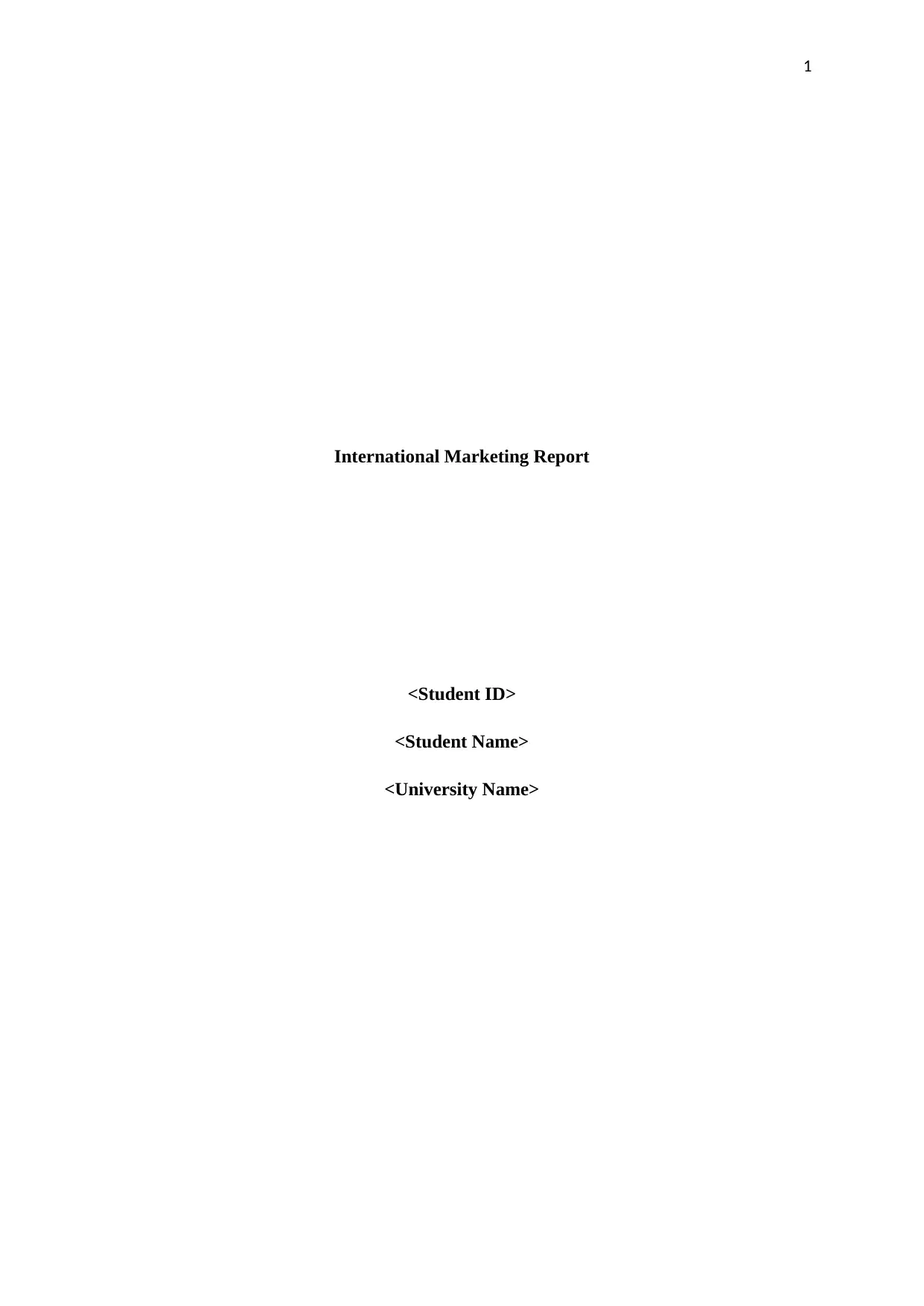
1
International Marketing Report
<Student ID>
<Student Name>
<University Name>
International Marketing Report
<Student ID>
<Student Name>
<University Name>
Paraphrase This Document
Need a fresh take? Get an instant paraphrase of this document with our AI Paraphraser
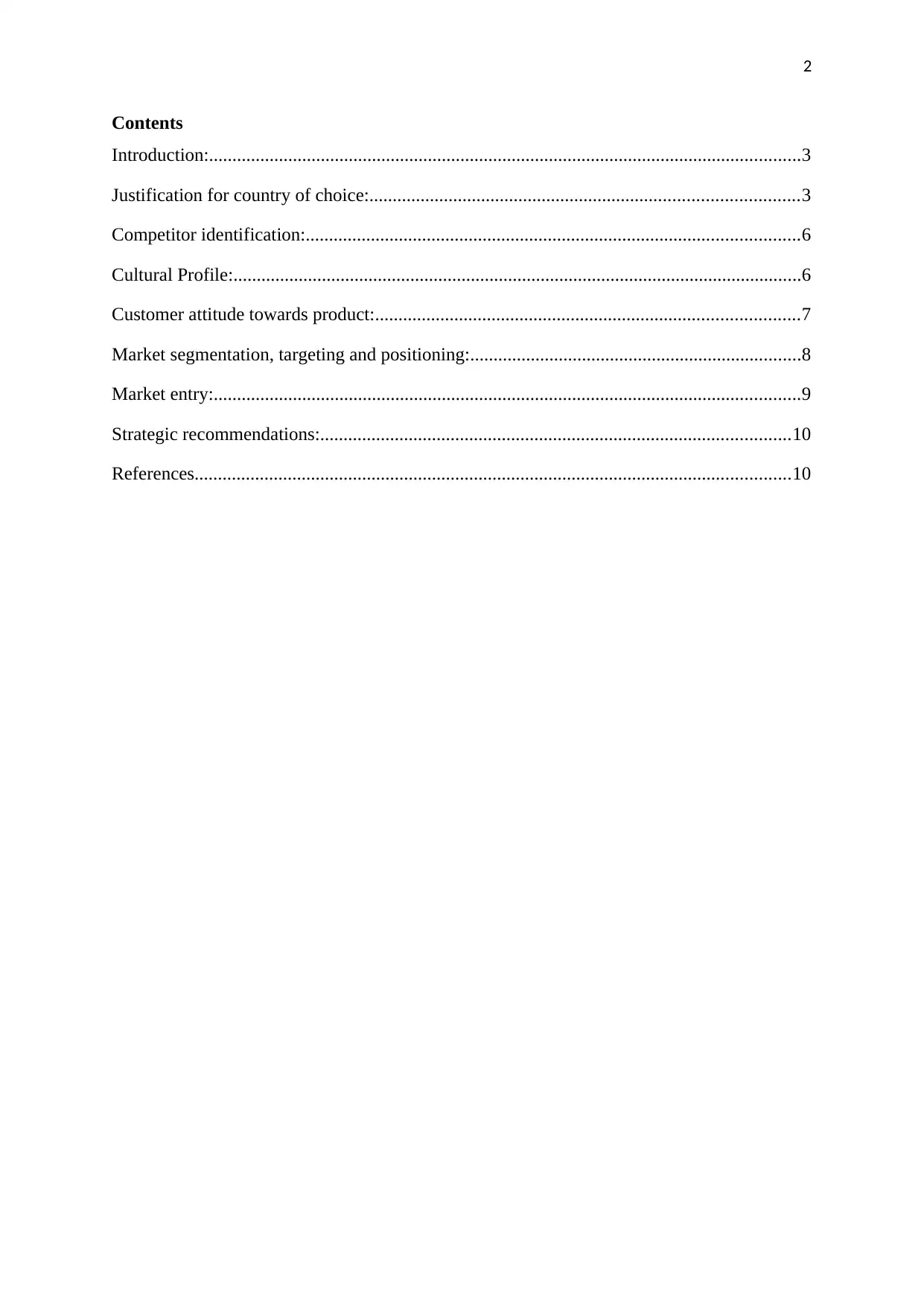
2
Contents
Introduction:...............................................................................................................................3
Justification for country of choice:............................................................................................3
Competitor identification:..........................................................................................................6
Cultural Profile:..........................................................................................................................6
Customer attitude towards product:...........................................................................................7
Market segmentation, targeting and positioning:.......................................................................8
Market entry:..............................................................................................................................9
Strategic recommendations:.....................................................................................................10
References................................................................................................................................10
Contents
Introduction:...............................................................................................................................3
Justification for country of choice:............................................................................................3
Competitor identification:..........................................................................................................6
Cultural Profile:..........................................................................................................................6
Customer attitude towards product:...........................................................................................7
Market segmentation, targeting and positioning:.......................................................................8
Market entry:..............................................................................................................................9
Strategic recommendations:.....................................................................................................10
References................................................................................................................................10
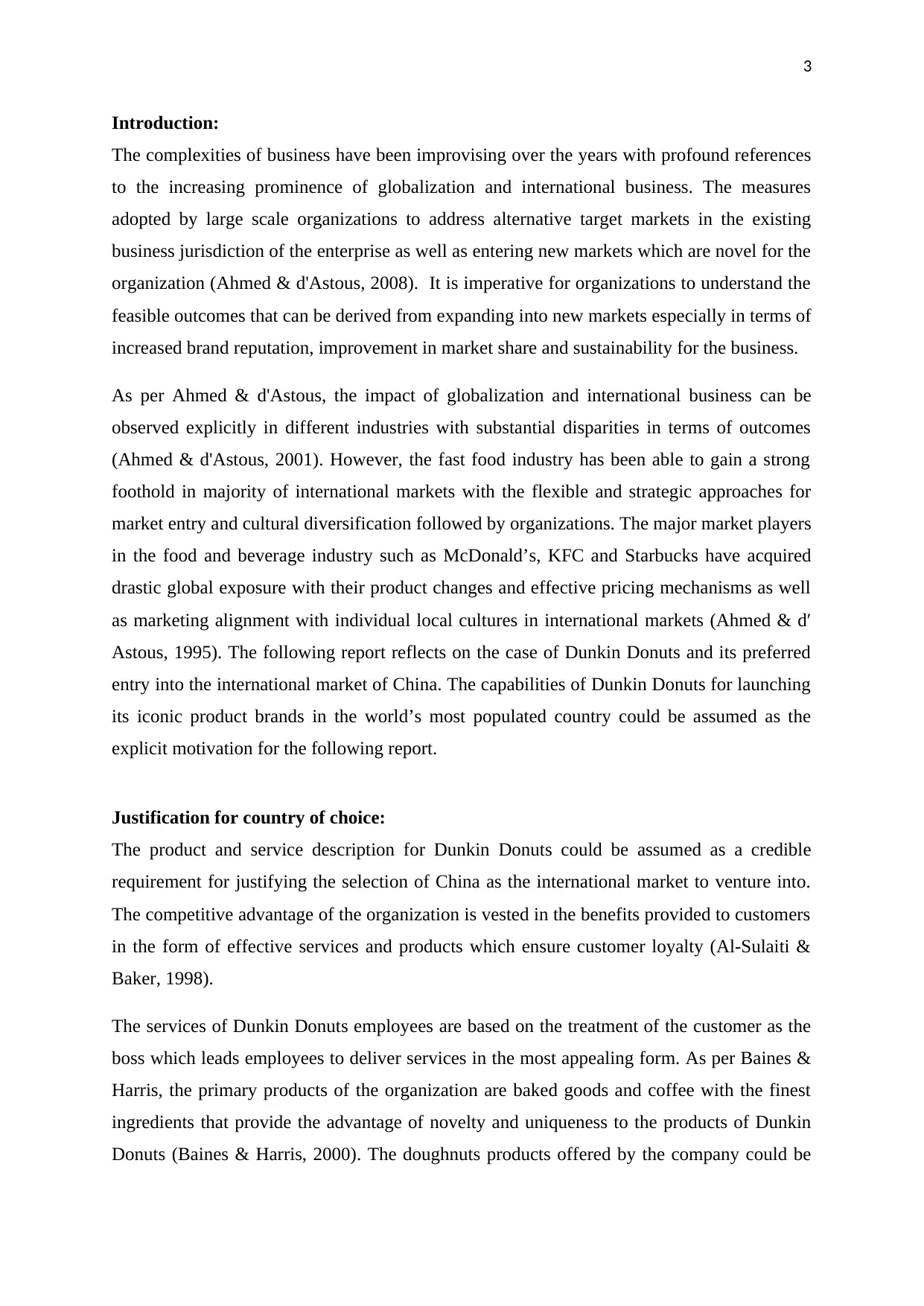
3
Introduction:
The complexities of business have been improvising over the years with profound references
to the increasing prominence of globalization and international business. The measures
adopted by large scale organizations to address alternative target markets in the existing
business jurisdiction of the enterprise as well as entering new markets which are novel for the
organization (Ahmed & d'Astous, 2008). It is imperative for organizations to understand the
feasible outcomes that can be derived from expanding into new markets especially in terms of
increased brand reputation, improvement in market share and sustainability for the business.
As per Ahmed & d'Astous, the impact of globalization and international business can be
observed explicitly in different industries with substantial disparities in terms of outcomes
(Ahmed & d'Astous, 2001). However, the fast food industry has been able to gain a strong
foothold in majority of international markets with the flexible and strategic approaches for
market entry and cultural diversification followed by organizations. The major market players
in the food and beverage industry such as McDonald’s, KFC and Starbucks have acquired
drastic global exposure with their product changes and effective pricing mechanisms as well
as marketing alignment with individual local cultures in international markets (Ahmed & d′
Astous, 1995). The following report reflects on the case of Dunkin Donuts and its preferred
entry into the international market of China. The capabilities of Dunkin Donuts for launching
its iconic product brands in the world’s most populated country could be assumed as the
explicit motivation for the following report.
Justification for country of choice:
The product and service description for Dunkin Donuts could be assumed as a credible
requirement for justifying the selection of China as the international market to venture into.
The competitive advantage of the organization is vested in the benefits provided to customers
in the form of effective services and products which ensure customer loyalty (Al-Sulaiti &
Baker, 1998).
The services of Dunkin Donuts employees are based on the treatment of the customer as the
boss which leads employees to deliver services in the most appealing form. As per Baines &
Harris, the primary products of the organization are baked goods and coffee with the finest
ingredients that provide the advantage of novelty and uniqueness to the products of Dunkin
Donuts (Baines & Harris, 2000). The doughnuts products offered by the company could be
Introduction:
The complexities of business have been improvising over the years with profound references
to the increasing prominence of globalization and international business. The measures
adopted by large scale organizations to address alternative target markets in the existing
business jurisdiction of the enterprise as well as entering new markets which are novel for the
organization (Ahmed & d'Astous, 2008). It is imperative for organizations to understand the
feasible outcomes that can be derived from expanding into new markets especially in terms of
increased brand reputation, improvement in market share and sustainability for the business.
As per Ahmed & d'Astous, the impact of globalization and international business can be
observed explicitly in different industries with substantial disparities in terms of outcomes
(Ahmed & d'Astous, 2001). However, the fast food industry has been able to gain a strong
foothold in majority of international markets with the flexible and strategic approaches for
market entry and cultural diversification followed by organizations. The major market players
in the food and beverage industry such as McDonald’s, KFC and Starbucks have acquired
drastic global exposure with their product changes and effective pricing mechanisms as well
as marketing alignment with individual local cultures in international markets (Ahmed & d′
Astous, 1995). The following report reflects on the case of Dunkin Donuts and its preferred
entry into the international market of China. The capabilities of Dunkin Donuts for launching
its iconic product brands in the world’s most populated country could be assumed as the
explicit motivation for the following report.
Justification for country of choice:
The product and service description for Dunkin Donuts could be assumed as a credible
requirement for justifying the selection of China as the international market to venture into.
The competitive advantage of the organization is vested in the benefits provided to customers
in the form of effective services and products which ensure customer loyalty (Al-Sulaiti &
Baker, 1998).
The services of Dunkin Donuts employees are based on the treatment of the customer as the
boss which leads employees to deliver services in the most appealing form. As per Baines &
Harris, the primary products of the organization are baked goods and coffee with the finest
ingredients that provide the advantage of novelty and uniqueness to the products of Dunkin
Donuts (Baines & Harris, 2000). The doughnuts products offered by the company could be
⊘ This is a preview!⊘
Do you want full access?
Subscribe today to unlock all pages.

Trusted by 1+ million students worldwide
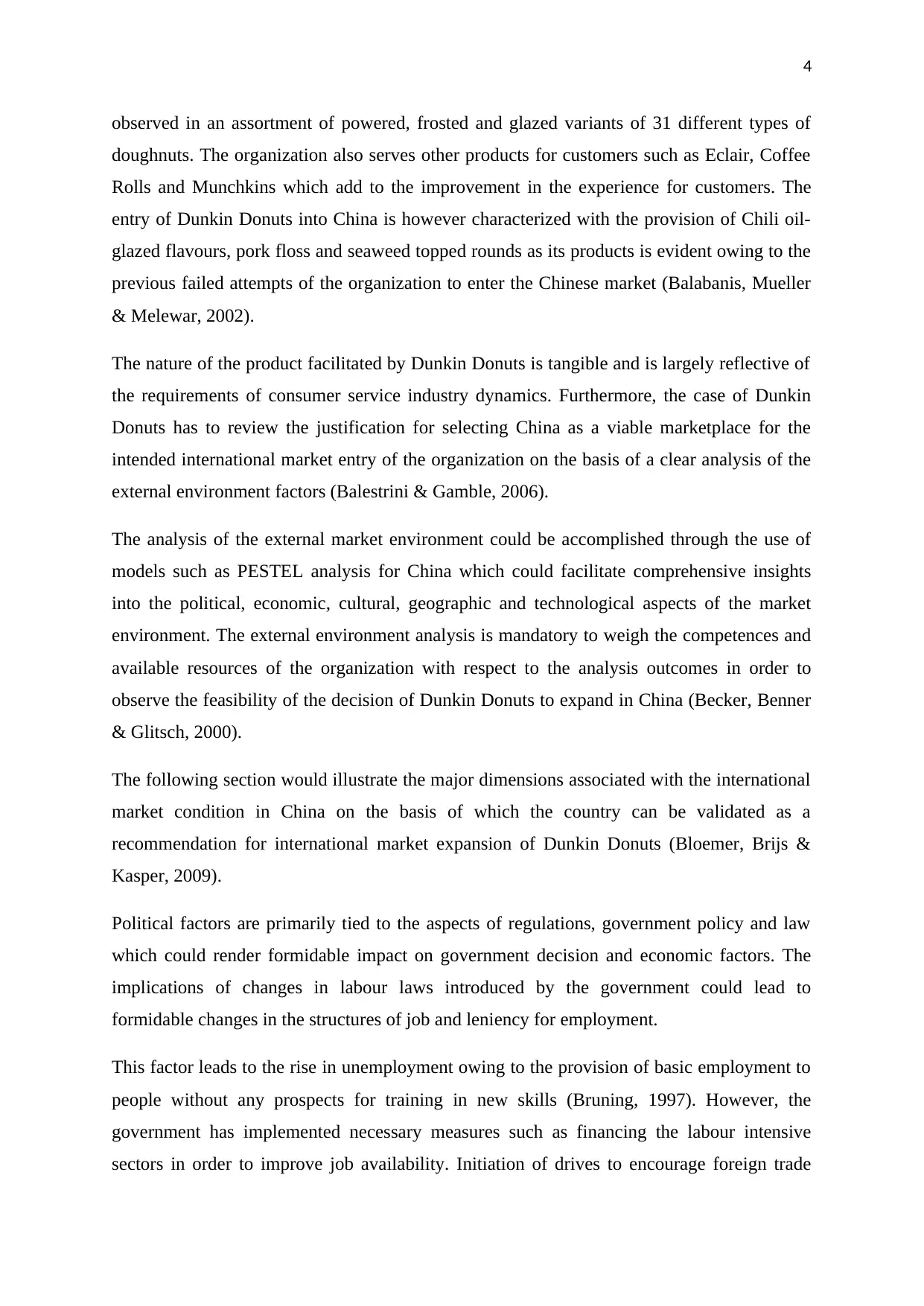
4
observed in an assortment of powered, frosted and glazed variants of 31 different types of
doughnuts. The organization also serves other products for customers such as Eclair, Coffee
Rolls and Munchkins which add to the improvement in the experience for customers. The
entry of Dunkin Donuts into China is however characterized with the provision of Chili oil-
glazed flavours, pork floss and seaweed topped rounds as its products is evident owing to the
previous failed attempts of the organization to enter the Chinese market (Balabanis, Mueller
& Melewar, 2002).
The nature of the product facilitated by Dunkin Donuts is tangible and is largely reflective of
the requirements of consumer service industry dynamics. Furthermore, the case of Dunkin
Donuts has to review the justification for selecting China as a viable marketplace for the
intended international market entry of the organization on the basis of a clear analysis of the
external environment factors (Balestrini & Gamble, 2006).
The analysis of the external market environment could be accomplished through the use of
models such as PESTEL analysis for China which could facilitate comprehensive insights
into the political, economic, cultural, geographic and technological aspects of the market
environment. The external environment analysis is mandatory to weigh the competences and
available resources of the organization with respect to the analysis outcomes in order to
observe the feasibility of the decision of Dunkin Donuts to expand in China (Becker, Benner
& Glitsch, 2000).
The following section would illustrate the major dimensions associated with the international
market condition in China on the basis of which the country can be validated as a
recommendation for international market expansion of Dunkin Donuts (Bloemer, Brijs &
Kasper, 2009).
Political factors are primarily tied to the aspects of regulations, government policy and law
which could render formidable impact on government decision and economic factors. The
implications of changes in labour laws introduced by the government could lead to
formidable changes in the structures of job and leniency for employment.
This factor leads to the rise in unemployment owing to the provision of basic employment to
people without any prospects for training in new skills (Bruning, 1997). However, the
government has implemented necessary measures such as financing the labour intensive
sectors in order to improve job availability. Initiation of drives to encourage foreign trade
observed in an assortment of powered, frosted and glazed variants of 31 different types of
doughnuts. The organization also serves other products for customers such as Eclair, Coffee
Rolls and Munchkins which add to the improvement in the experience for customers. The
entry of Dunkin Donuts into China is however characterized with the provision of Chili oil-
glazed flavours, pork floss and seaweed topped rounds as its products is evident owing to the
previous failed attempts of the organization to enter the Chinese market (Balabanis, Mueller
& Melewar, 2002).
The nature of the product facilitated by Dunkin Donuts is tangible and is largely reflective of
the requirements of consumer service industry dynamics. Furthermore, the case of Dunkin
Donuts has to review the justification for selecting China as a viable marketplace for the
intended international market entry of the organization on the basis of a clear analysis of the
external environment factors (Balestrini & Gamble, 2006).
The analysis of the external market environment could be accomplished through the use of
models such as PESTEL analysis for China which could facilitate comprehensive insights
into the political, economic, cultural, geographic and technological aspects of the market
environment. The external environment analysis is mandatory to weigh the competences and
available resources of the organization with respect to the analysis outcomes in order to
observe the feasibility of the decision of Dunkin Donuts to expand in China (Becker, Benner
& Glitsch, 2000).
The following section would illustrate the major dimensions associated with the international
market condition in China on the basis of which the country can be validated as a
recommendation for international market expansion of Dunkin Donuts (Bloemer, Brijs &
Kasper, 2009).
Political factors are primarily tied to the aspects of regulations, government policy and law
which could render formidable impact on government decision and economic factors. The
implications of changes in labour laws introduced by the government could lead to
formidable changes in the structures of job and leniency for employment.
This factor leads to the rise in unemployment owing to the provision of basic employment to
people without any prospects for training in new skills (Bruning, 1997). However, the
government has implemented necessary measures such as financing the labour intensive
sectors in order to improve job availability. Initiation of drives to encourage foreign trade
Paraphrase This Document
Need a fresh take? Get an instant paraphrase of this document with our AI Paraphraser
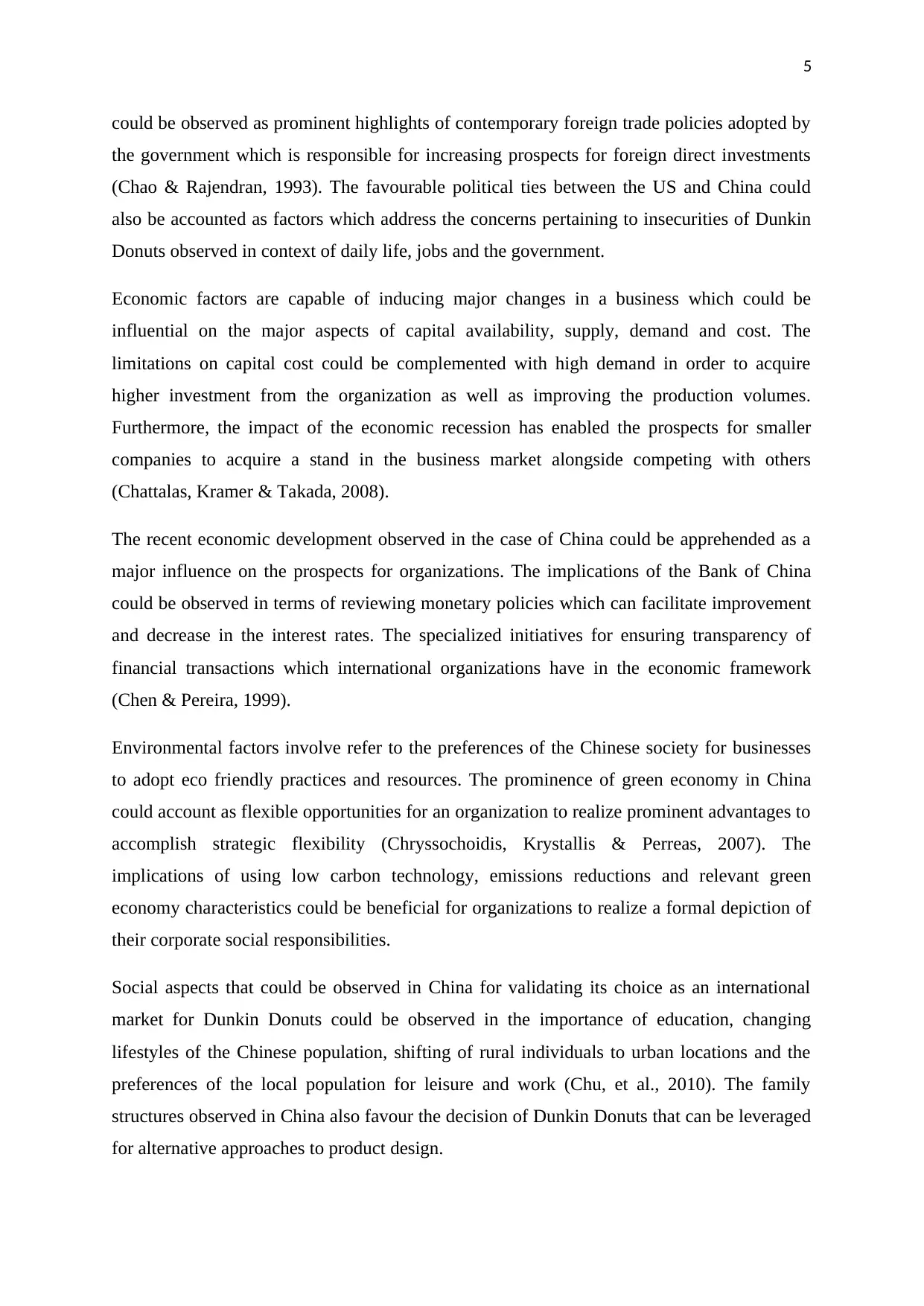
5
could be observed as prominent highlights of contemporary foreign trade policies adopted by
the government which is responsible for increasing prospects for foreign direct investments
(Chao & Rajendran, 1993). The favourable political ties between the US and China could
also be accounted as factors which address the concerns pertaining to insecurities of Dunkin
Donuts observed in context of daily life, jobs and the government.
Economic factors are capable of inducing major changes in a business which could be
influential on the major aspects of capital availability, supply, demand and cost. The
limitations on capital cost could be complemented with high demand in order to acquire
higher investment from the organization as well as improving the production volumes.
Furthermore, the impact of the economic recession has enabled the prospects for smaller
companies to acquire a stand in the business market alongside competing with others
(Chattalas, Kramer & Takada, 2008).
The recent economic development observed in the case of China could be apprehended as a
major influence on the prospects for organizations. The implications of the Bank of China
could be observed in terms of reviewing monetary policies which can facilitate improvement
and decrease in the interest rates. The specialized initiatives for ensuring transparency of
financial transactions which international organizations have in the economic framework
(Chen & Pereira, 1999).
Environmental factors involve refer to the preferences of the Chinese society for businesses
to adopt eco friendly practices and resources. The prominence of green economy in China
could account as flexible opportunities for an organization to realize prominent advantages to
accomplish strategic flexibility (Chryssochoidis, Krystallis & Perreas, 2007). The
implications of using low carbon technology, emissions reductions and relevant green
economy characteristics could be beneficial for organizations to realize a formal depiction of
their corporate social responsibilities.
Social aspects that could be observed in China for validating its choice as an international
market for Dunkin Donuts could be observed in the importance of education, changing
lifestyles of the Chinese population, shifting of rural individuals to urban locations and the
preferences of the local population for leisure and work (Chu, et al., 2010). The family
structures observed in China also favour the decision of Dunkin Donuts that can be leveraged
for alternative approaches to product design.
could be observed as prominent highlights of contemporary foreign trade policies adopted by
the government which is responsible for increasing prospects for foreign direct investments
(Chao & Rajendran, 1993). The favourable political ties between the US and China could
also be accounted as factors which address the concerns pertaining to insecurities of Dunkin
Donuts observed in context of daily life, jobs and the government.
Economic factors are capable of inducing major changes in a business which could be
influential on the major aspects of capital availability, supply, demand and cost. The
limitations on capital cost could be complemented with high demand in order to acquire
higher investment from the organization as well as improving the production volumes.
Furthermore, the impact of the economic recession has enabled the prospects for smaller
companies to acquire a stand in the business market alongside competing with others
(Chattalas, Kramer & Takada, 2008).
The recent economic development observed in the case of China could be apprehended as a
major influence on the prospects for organizations. The implications of the Bank of China
could be observed in terms of reviewing monetary policies which can facilitate improvement
and decrease in the interest rates. The specialized initiatives for ensuring transparency of
financial transactions which international organizations have in the economic framework
(Chen & Pereira, 1999).
Environmental factors involve refer to the preferences of the Chinese society for businesses
to adopt eco friendly practices and resources. The prominence of green economy in China
could account as flexible opportunities for an organization to realize prominent advantages to
accomplish strategic flexibility (Chryssochoidis, Krystallis & Perreas, 2007). The
implications of using low carbon technology, emissions reductions and relevant green
economy characteristics could be beneficial for organizations to realize a formal depiction of
their corporate social responsibilities.
Social aspects that could be observed in China for validating its choice as an international
market for Dunkin Donuts could be observed in the importance of education, changing
lifestyles of the Chinese population, shifting of rural individuals to urban locations and the
preferences of the local population for leisure and work (Chu, et al., 2010). The family
structures observed in China also favour the decision of Dunkin Donuts that can be leveraged
for alternative approaches to product design.
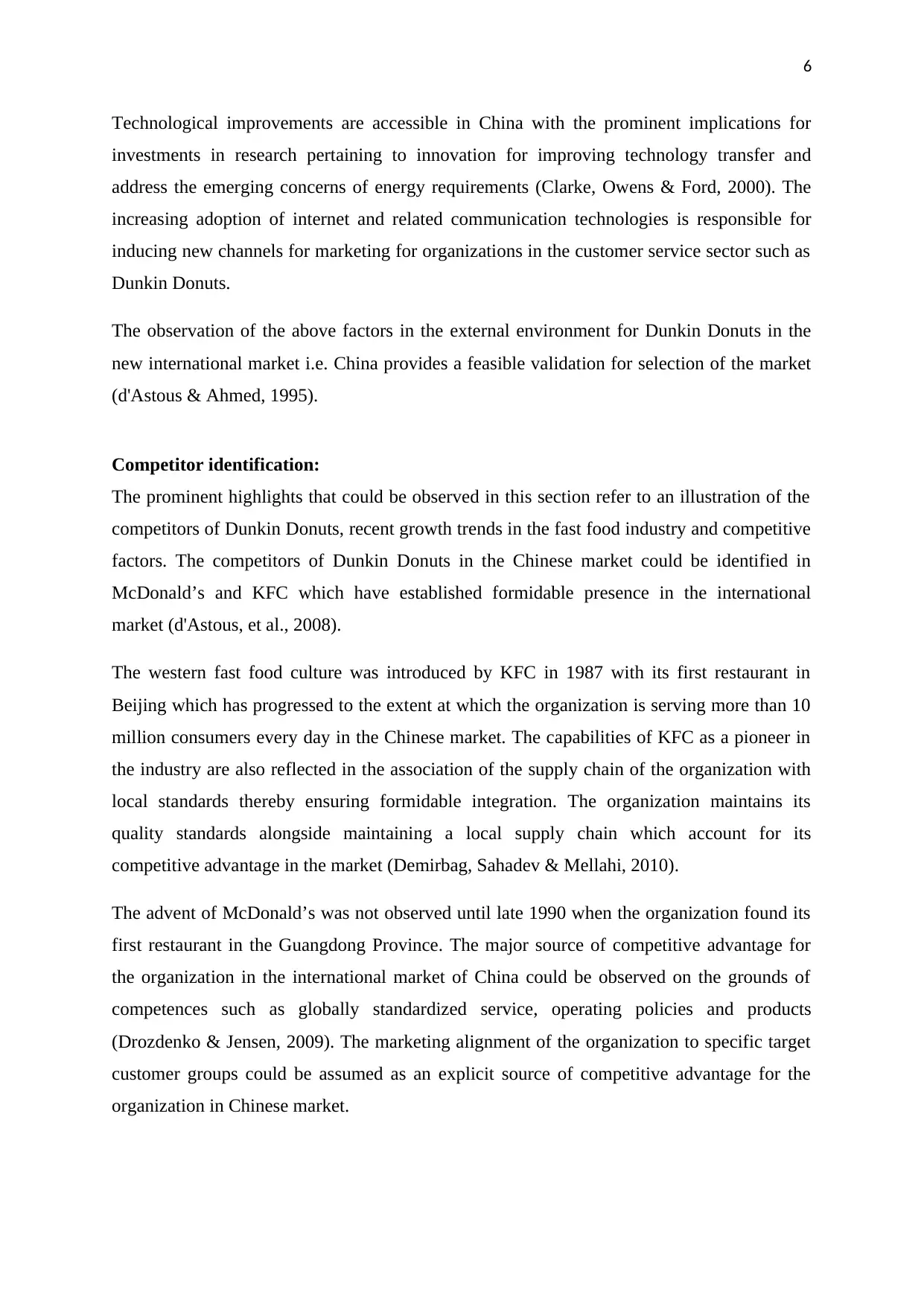
6
Technological improvements are accessible in China with the prominent implications for
investments in research pertaining to innovation for improving technology transfer and
address the emerging concerns of energy requirements (Clarke, Owens & Ford, 2000). The
increasing adoption of internet and related communication technologies is responsible for
inducing new channels for marketing for organizations in the customer service sector such as
Dunkin Donuts.
The observation of the above factors in the external environment for Dunkin Donuts in the
new international market i.e. China provides a feasible validation for selection of the market
(d'Astous & Ahmed, 1995).
Competitor identification:
The prominent highlights that could be observed in this section refer to an illustration of the
competitors of Dunkin Donuts, recent growth trends in the fast food industry and competitive
factors. The competitors of Dunkin Donuts in the Chinese market could be identified in
McDonald’s and KFC which have established formidable presence in the international
market (d'Astous, et al., 2008).
The western fast food culture was introduced by KFC in 1987 with its first restaurant in
Beijing which has progressed to the extent at which the organization is serving more than 10
million consumers every day in the Chinese market. The capabilities of KFC as a pioneer in
the industry are also reflected in the association of the supply chain of the organization with
local standards thereby ensuring formidable integration. The organization maintains its
quality standards alongside maintaining a local supply chain which account for its
competitive advantage in the market (Demirbag, Sahadev & Mellahi, 2010).
The advent of McDonald’s was not observed until late 1990 when the organization found its
first restaurant in the Guangdong Province. The major source of competitive advantage for
the organization in the international market of China could be observed on the grounds of
competences such as globally standardized service, operating policies and products
(Drozdenko & Jensen, 2009). The marketing alignment of the organization to specific target
customer groups could be assumed as an explicit source of competitive advantage for the
organization in Chinese market.
Technological improvements are accessible in China with the prominent implications for
investments in research pertaining to innovation for improving technology transfer and
address the emerging concerns of energy requirements (Clarke, Owens & Ford, 2000). The
increasing adoption of internet and related communication technologies is responsible for
inducing new channels for marketing for organizations in the customer service sector such as
Dunkin Donuts.
The observation of the above factors in the external environment for Dunkin Donuts in the
new international market i.e. China provides a feasible validation for selection of the market
(d'Astous & Ahmed, 1995).
Competitor identification:
The prominent highlights that could be observed in this section refer to an illustration of the
competitors of Dunkin Donuts, recent growth trends in the fast food industry and competitive
factors. The competitors of Dunkin Donuts in the Chinese market could be identified in
McDonald’s and KFC which have established formidable presence in the international
market (d'Astous, et al., 2008).
The western fast food culture was introduced by KFC in 1987 with its first restaurant in
Beijing which has progressed to the extent at which the organization is serving more than 10
million consumers every day in the Chinese market. The capabilities of KFC as a pioneer in
the industry are also reflected in the association of the supply chain of the organization with
local standards thereby ensuring formidable integration. The organization maintains its
quality standards alongside maintaining a local supply chain which account for its
competitive advantage in the market (Demirbag, Sahadev & Mellahi, 2010).
The advent of McDonald’s was not observed until late 1990 when the organization found its
first restaurant in the Guangdong Province. The major source of competitive advantage for
the organization in the international market of China could be observed on the grounds of
competences such as globally standardized service, operating policies and products
(Drozdenko & Jensen, 2009). The marketing alignment of the organization to specific target
customer groups could be assumed as an explicit source of competitive advantage for the
organization in Chinese market.
⊘ This is a preview!⊘
Do you want full access?
Subscribe today to unlock all pages.

Trusted by 1+ million students worldwide
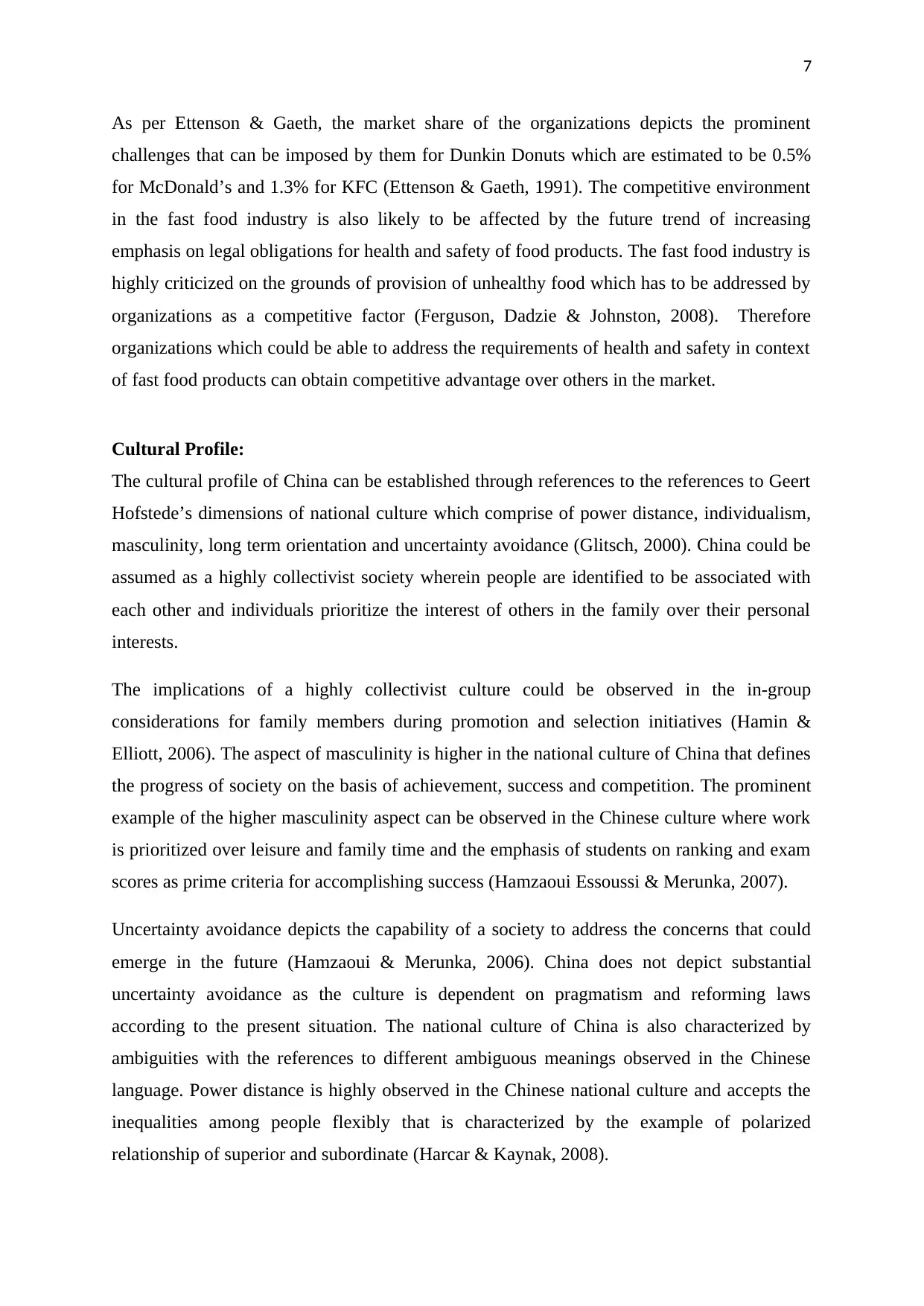
7
As per Ettenson & Gaeth, the market share of the organizations depicts the prominent
challenges that can be imposed by them for Dunkin Donuts which are estimated to be 0.5%
for McDonald’s and 1.3% for KFC (Ettenson & Gaeth, 1991). The competitive environment
in the fast food industry is also likely to be affected by the future trend of increasing
emphasis on legal obligations for health and safety of food products. The fast food industry is
highly criticized on the grounds of provision of unhealthy food which has to be addressed by
organizations as a competitive factor (Ferguson, Dadzie & Johnston, 2008). Therefore
organizations which could be able to address the requirements of health and safety in context
of fast food products can obtain competitive advantage over others in the market.
Cultural Profile:
The cultural profile of China can be established through references to the references to Geert
Hofstede’s dimensions of national culture which comprise of power distance, individualism,
masculinity, long term orientation and uncertainty avoidance (Glitsch, 2000). China could be
assumed as a highly collectivist society wherein people are identified to be associated with
each other and individuals prioritize the interest of others in the family over their personal
interests.
The implications of a highly collectivist culture could be observed in the in-group
considerations for family members during promotion and selection initiatives (Hamin &
Elliott, 2006). The aspect of masculinity is higher in the national culture of China that defines
the progress of society on the basis of achievement, success and competition. The prominent
example of the higher masculinity aspect can be observed in the Chinese culture where work
is prioritized over leisure and family time and the emphasis of students on ranking and exam
scores as prime criteria for accomplishing success (Hamzaoui Essoussi & Merunka, 2007).
Uncertainty avoidance depicts the capability of a society to address the concerns that could
emerge in the future (Hamzaoui & Merunka, 2006). China does not depict substantial
uncertainty avoidance as the culture is dependent on pragmatism and reforming laws
according to the present situation. The national culture of China is also characterized by
ambiguities with the references to different ambiguous meanings observed in the Chinese
language. Power distance is highly observed in the Chinese national culture and accepts the
inequalities among people flexibly that is characterized by the example of polarized
relationship of superior and subordinate (Harcar & Kaynak, 2008).
As per Ettenson & Gaeth, the market share of the organizations depicts the prominent
challenges that can be imposed by them for Dunkin Donuts which are estimated to be 0.5%
for McDonald’s and 1.3% for KFC (Ettenson & Gaeth, 1991). The competitive environment
in the fast food industry is also likely to be affected by the future trend of increasing
emphasis on legal obligations for health and safety of food products. The fast food industry is
highly criticized on the grounds of provision of unhealthy food which has to be addressed by
organizations as a competitive factor (Ferguson, Dadzie & Johnston, 2008). Therefore
organizations which could be able to address the requirements of health and safety in context
of fast food products can obtain competitive advantage over others in the market.
Cultural Profile:
The cultural profile of China can be established through references to the references to Geert
Hofstede’s dimensions of national culture which comprise of power distance, individualism,
masculinity, long term orientation and uncertainty avoidance (Glitsch, 2000). China could be
assumed as a highly collectivist society wherein people are identified to be associated with
each other and individuals prioritize the interest of others in the family over their personal
interests.
The implications of a highly collectivist culture could be observed in the in-group
considerations for family members during promotion and selection initiatives (Hamin &
Elliott, 2006). The aspect of masculinity is higher in the national culture of China that defines
the progress of society on the basis of achievement, success and competition. The prominent
example of the higher masculinity aspect can be observed in the Chinese culture where work
is prioritized over leisure and family time and the emphasis of students on ranking and exam
scores as prime criteria for accomplishing success (Hamzaoui Essoussi & Merunka, 2007).
Uncertainty avoidance depicts the capability of a society to address the concerns that could
emerge in the future (Hamzaoui & Merunka, 2006). China does not depict substantial
uncertainty avoidance as the culture is dependent on pragmatism and reforming laws
according to the present situation. The national culture of China is also characterized by
ambiguities with the references to different ambiguous meanings observed in the Chinese
language. Power distance is highly observed in the Chinese national culture and accepts the
inequalities among people flexibly that is characterized by the example of polarized
relationship of superior and subordinate (Harcar & Kaynak, 2008).
Paraphrase This Document
Need a fresh take? Get an instant paraphrase of this document with our AI Paraphraser
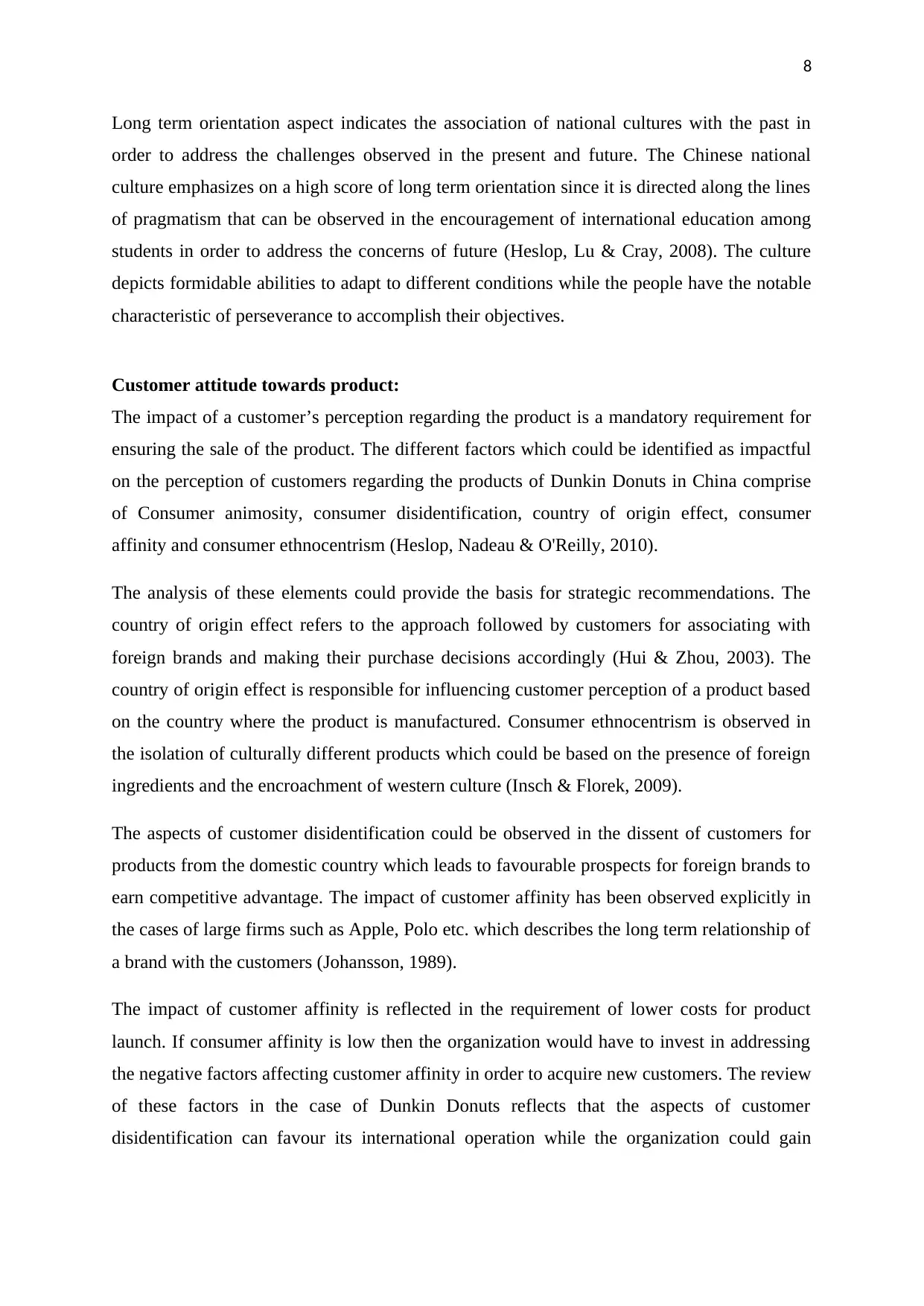
8
Long term orientation aspect indicates the association of national cultures with the past in
order to address the challenges observed in the present and future. The Chinese national
culture emphasizes on a high score of long term orientation since it is directed along the lines
of pragmatism that can be observed in the encouragement of international education among
students in order to address the concerns of future (Heslop, Lu & Cray, 2008). The culture
depicts formidable abilities to adapt to different conditions while the people have the notable
characteristic of perseverance to accomplish their objectives.
Customer attitude towards product:
The impact of a customer’s perception regarding the product is a mandatory requirement for
ensuring the sale of the product. The different factors which could be identified as impactful
on the perception of customers regarding the products of Dunkin Donuts in China comprise
of Consumer animosity, consumer disidentification, country of origin effect, consumer
affinity and consumer ethnocentrism (Heslop, Nadeau & O'Reilly, 2010).
The analysis of these elements could provide the basis for strategic recommendations. The
country of origin effect refers to the approach followed by customers for associating with
foreign brands and making their purchase decisions accordingly (Hui & Zhou, 2003). The
country of origin effect is responsible for influencing customer perception of a product based
on the country where the product is manufactured. Consumer ethnocentrism is observed in
the isolation of culturally different products which could be based on the presence of foreign
ingredients and the encroachment of western culture (Insch & Florek, 2009).
The aspects of customer disidentification could be observed in the dissent of customers for
products from the domestic country which leads to favourable prospects for foreign brands to
earn competitive advantage. The impact of customer affinity has been observed explicitly in
the cases of large firms such as Apple, Polo etc. which describes the long term relationship of
a brand with the customers (Johansson, 1989).
The impact of customer affinity is reflected in the requirement of lower costs for product
launch. If consumer affinity is low then the organization would have to invest in addressing
the negative factors affecting customer affinity in order to acquire new customers. The review
of these factors in the case of Dunkin Donuts reflects that the aspects of customer
disidentification can favour its international operation while the organization could gain
Long term orientation aspect indicates the association of national cultures with the past in
order to address the challenges observed in the present and future. The Chinese national
culture emphasizes on a high score of long term orientation since it is directed along the lines
of pragmatism that can be observed in the encouragement of international education among
students in order to address the concerns of future (Heslop, Lu & Cray, 2008). The culture
depicts formidable abilities to adapt to different conditions while the people have the notable
characteristic of perseverance to accomplish their objectives.
Customer attitude towards product:
The impact of a customer’s perception regarding the product is a mandatory requirement for
ensuring the sale of the product. The different factors which could be identified as impactful
on the perception of customers regarding the products of Dunkin Donuts in China comprise
of Consumer animosity, consumer disidentification, country of origin effect, consumer
affinity and consumer ethnocentrism (Heslop, Nadeau & O'Reilly, 2010).
The analysis of these elements could provide the basis for strategic recommendations. The
country of origin effect refers to the approach followed by customers for associating with
foreign brands and making their purchase decisions accordingly (Hui & Zhou, 2003). The
country of origin effect is responsible for influencing customer perception of a product based
on the country where the product is manufactured. Consumer ethnocentrism is observed in
the isolation of culturally different products which could be based on the presence of foreign
ingredients and the encroachment of western culture (Insch & Florek, 2009).
The aspects of customer disidentification could be observed in the dissent of customers for
products from the domestic country which leads to favourable prospects for foreign brands to
earn competitive advantage. The impact of customer affinity has been observed explicitly in
the cases of large firms such as Apple, Polo etc. which describes the long term relationship of
a brand with the customers (Johansson, 1989).
The impact of customer affinity is reflected in the requirement of lower costs for product
launch. If consumer affinity is low then the organization would have to invest in addressing
the negative factors affecting customer affinity in order to acquire new customers. The review
of these factors in the case of Dunkin Donuts reflects that the aspects of customer
disidentification can favour its international operation while the organization could gain
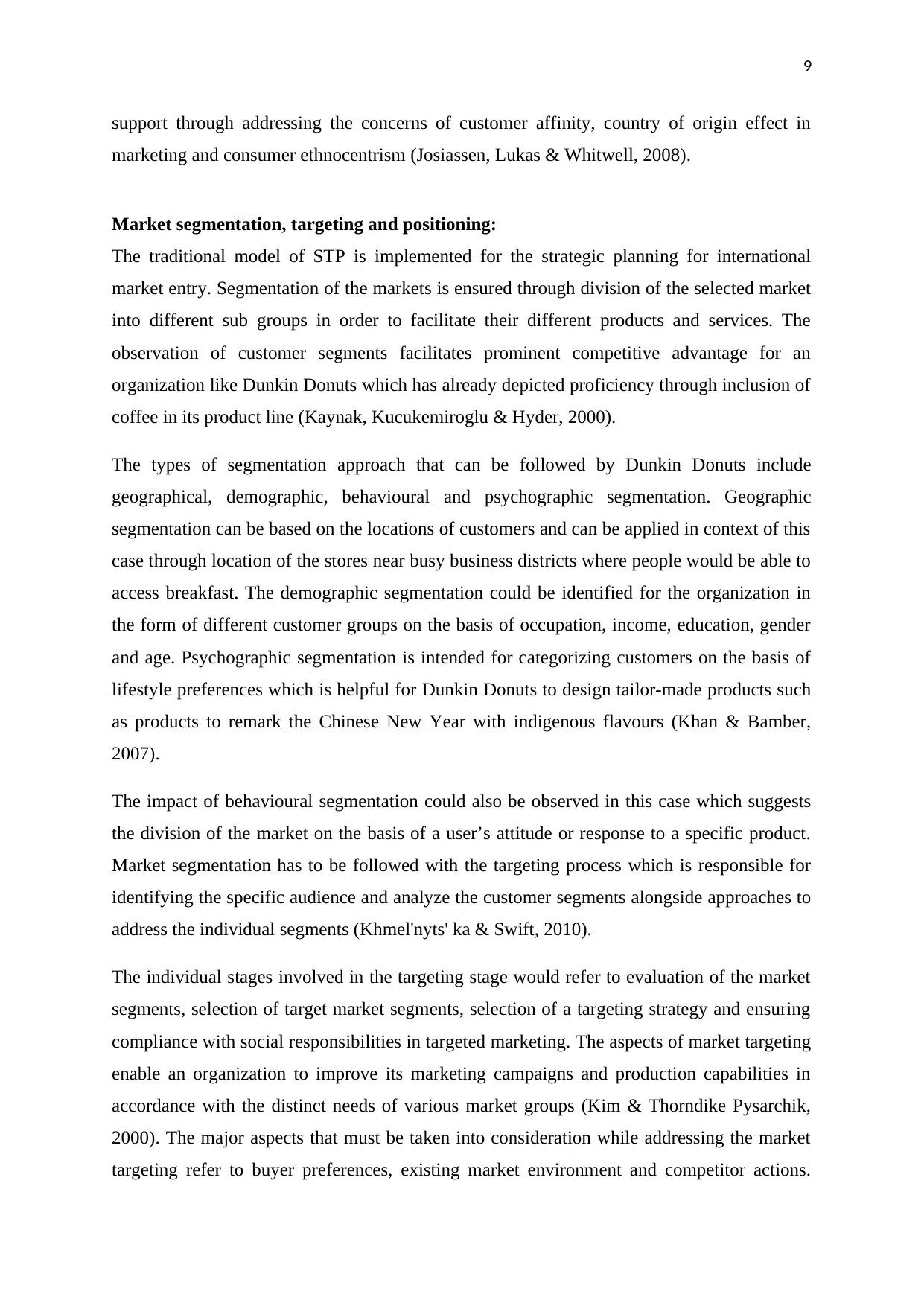
9
support through addressing the concerns of customer affinity, country of origin effect in
marketing and consumer ethnocentrism (Josiassen, Lukas & Whitwell, 2008).
Market segmentation, targeting and positioning:
The traditional model of STP is implemented for the strategic planning for international
market entry. Segmentation of the markets is ensured through division of the selected market
into different sub groups in order to facilitate their different products and services. The
observation of customer segments facilitates prominent competitive advantage for an
organization like Dunkin Donuts which has already depicted proficiency through inclusion of
coffee in its product line (Kaynak, Kucukemiroglu & Hyder, 2000).
The types of segmentation approach that can be followed by Dunkin Donuts include
geographical, demographic, behavioural and psychographic segmentation. Geographic
segmentation can be based on the locations of customers and can be applied in context of this
case through location of the stores near busy business districts where people would be able to
access breakfast. The demographic segmentation could be identified for the organization in
the form of different customer groups on the basis of occupation, income, education, gender
and age. Psychographic segmentation is intended for categorizing customers on the basis of
lifestyle preferences which is helpful for Dunkin Donuts to design tailor-made products such
as products to remark the Chinese New Year with indigenous flavours (Khan & Bamber,
2007).
The impact of behavioural segmentation could also be observed in this case which suggests
the division of the market on the basis of a user’s attitude or response to a specific product.
Market segmentation has to be followed with the targeting process which is responsible for
identifying the specific audience and analyze the customer segments alongside approaches to
address the individual segments (Khmel'nyts' ka & Swift, 2010).
The individual stages involved in the targeting stage would refer to evaluation of the market
segments, selection of target market segments, selection of a targeting strategy and ensuring
compliance with social responsibilities in targeted marketing. The aspects of market targeting
enable an organization to improve its marketing campaigns and production capabilities in
accordance with the distinct needs of various market groups (Kim & Thorndike Pysarchik,
2000). The major aspects that must be taken into consideration while addressing the market
targeting refer to buyer preferences, existing market environment and competitor actions.
support through addressing the concerns of customer affinity, country of origin effect in
marketing and consumer ethnocentrism (Josiassen, Lukas & Whitwell, 2008).
Market segmentation, targeting and positioning:
The traditional model of STP is implemented for the strategic planning for international
market entry. Segmentation of the markets is ensured through division of the selected market
into different sub groups in order to facilitate their different products and services. The
observation of customer segments facilitates prominent competitive advantage for an
organization like Dunkin Donuts which has already depicted proficiency through inclusion of
coffee in its product line (Kaynak, Kucukemiroglu & Hyder, 2000).
The types of segmentation approach that can be followed by Dunkin Donuts include
geographical, demographic, behavioural and psychographic segmentation. Geographic
segmentation can be based on the locations of customers and can be applied in context of this
case through location of the stores near busy business districts where people would be able to
access breakfast. The demographic segmentation could be identified for the organization in
the form of different customer groups on the basis of occupation, income, education, gender
and age. Psychographic segmentation is intended for categorizing customers on the basis of
lifestyle preferences which is helpful for Dunkin Donuts to design tailor-made products such
as products to remark the Chinese New Year with indigenous flavours (Khan & Bamber,
2007).
The impact of behavioural segmentation could also be observed in this case which suggests
the division of the market on the basis of a user’s attitude or response to a specific product.
Market segmentation has to be followed with the targeting process which is responsible for
identifying the specific audience and analyze the customer segments alongside approaches to
address the individual segments (Khmel'nyts' ka & Swift, 2010).
The individual stages involved in the targeting stage would refer to evaluation of the market
segments, selection of target market segments, selection of a targeting strategy and ensuring
compliance with social responsibilities in targeted marketing. The aspects of market targeting
enable an organization to improve its marketing campaigns and production capabilities in
accordance with the distinct needs of various market groups (Kim & Thorndike Pysarchik,
2000). The major aspects that must be taken into consideration while addressing the market
targeting refer to buyer preferences, existing market environment and competitor actions.
⊘ This is a preview!⊘
Do you want full access?
Subscribe today to unlock all pages.

Trusted by 1+ million students worldwide
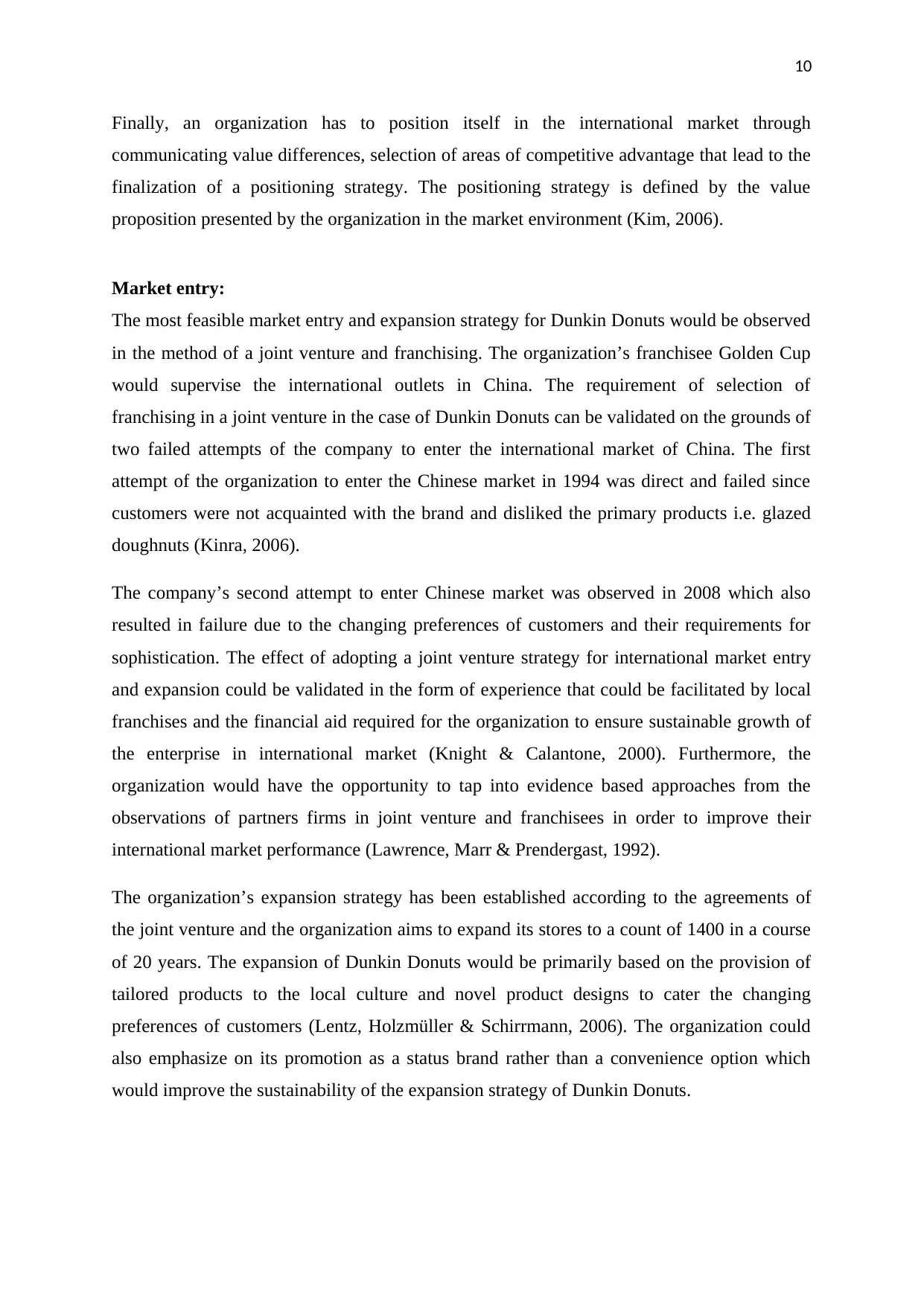
10
Finally, an organization has to position itself in the international market through
communicating value differences, selection of areas of competitive advantage that lead to the
finalization of a positioning strategy. The positioning strategy is defined by the value
proposition presented by the organization in the market environment (Kim, 2006).
Market entry:
The most feasible market entry and expansion strategy for Dunkin Donuts would be observed
in the method of a joint venture and franchising. The organization’s franchisee Golden Cup
would supervise the international outlets in China. The requirement of selection of
franchising in a joint venture in the case of Dunkin Donuts can be validated on the grounds of
two failed attempts of the company to enter the international market of China. The first
attempt of the organization to enter the Chinese market in 1994 was direct and failed since
customers were not acquainted with the brand and disliked the primary products i.e. glazed
doughnuts (Kinra, 2006).
The company’s second attempt to enter Chinese market was observed in 2008 which also
resulted in failure due to the changing preferences of customers and their requirements for
sophistication. The effect of adopting a joint venture strategy for international market entry
and expansion could be validated in the form of experience that could be facilitated by local
franchises and the financial aid required for the organization to ensure sustainable growth of
the enterprise in international market (Knight & Calantone, 2000). Furthermore, the
organization would have the opportunity to tap into evidence based approaches from the
observations of partners firms in joint venture and franchisees in order to improve their
international market performance (Lawrence, Marr & Prendergast, 1992).
The organization’s expansion strategy has been established according to the agreements of
the joint venture and the organization aims to expand its stores to a count of 1400 in a course
of 20 years. The expansion of Dunkin Donuts would be primarily based on the provision of
tailored products to the local culture and novel product designs to cater the changing
preferences of customers (Lentz, Holzmüller & Schirrmann, 2006). The organization could
also emphasize on its promotion as a status brand rather than a convenience option which
would improve the sustainability of the expansion strategy of Dunkin Donuts.
Finally, an organization has to position itself in the international market through
communicating value differences, selection of areas of competitive advantage that lead to the
finalization of a positioning strategy. The positioning strategy is defined by the value
proposition presented by the organization in the market environment (Kim, 2006).
Market entry:
The most feasible market entry and expansion strategy for Dunkin Donuts would be observed
in the method of a joint venture and franchising. The organization’s franchisee Golden Cup
would supervise the international outlets in China. The requirement of selection of
franchising in a joint venture in the case of Dunkin Donuts can be validated on the grounds of
two failed attempts of the company to enter the international market of China. The first
attempt of the organization to enter the Chinese market in 1994 was direct and failed since
customers were not acquainted with the brand and disliked the primary products i.e. glazed
doughnuts (Kinra, 2006).
The company’s second attempt to enter Chinese market was observed in 2008 which also
resulted in failure due to the changing preferences of customers and their requirements for
sophistication. The effect of adopting a joint venture strategy for international market entry
and expansion could be validated in the form of experience that could be facilitated by local
franchises and the financial aid required for the organization to ensure sustainable growth of
the enterprise in international market (Knight & Calantone, 2000). Furthermore, the
organization would have the opportunity to tap into evidence based approaches from the
observations of partners firms in joint venture and franchisees in order to improve their
international market performance (Lawrence, Marr & Prendergast, 1992).
The organization’s expansion strategy has been established according to the agreements of
the joint venture and the organization aims to expand its stores to a count of 1400 in a course
of 20 years. The expansion of Dunkin Donuts would be primarily based on the provision of
tailored products to the local culture and novel product designs to cater the changing
preferences of customers (Lentz, Holzmüller & Schirrmann, 2006). The organization could
also emphasize on its promotion as a status brand rather than a convenience option which
would improve the sustainability of the expansion strategy of Dunkin Donuts.
Paraphrase This Document
Need a fresh take? Get an instant paraphrase of this document with our AI Paraphraser
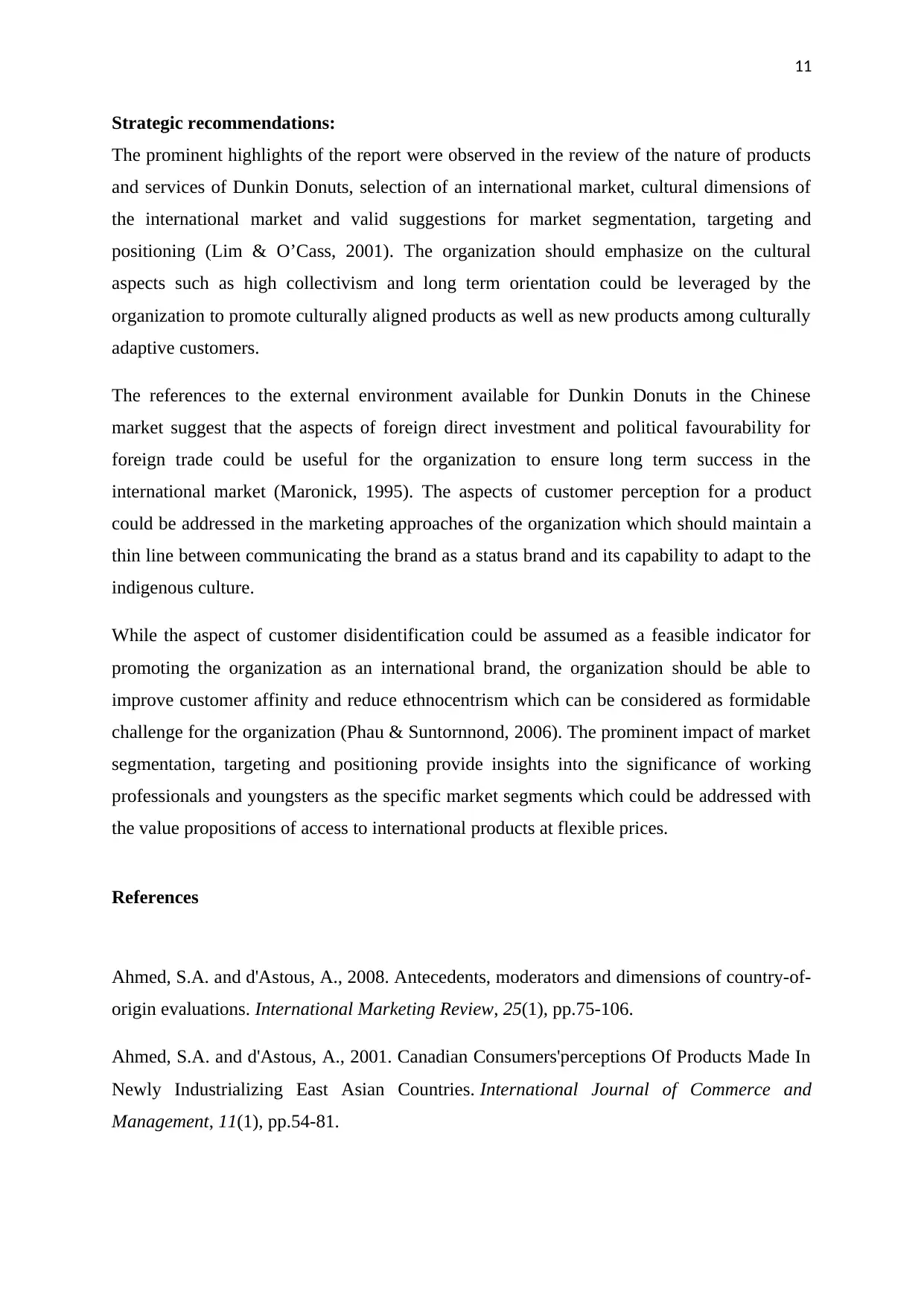
11
Strategic recommendations:
The prominent highlights of the report were observed in the review of the nature of products
and services of Dunkin Donuts, selection of an international market, cultural dimensions of
the international market and valid suggestions for market segmentation, targeting and
positioning (Lim & O’Cass, 2001). The organization should emphasize on the cultural
aspects such as high collectivism and long term orientation could be leveraged by the
organization to promote culturally aligned products as well as new products among culturally
adaptive customers.
The references to the external environment available for Dunkin Donuts in the Chinese
market suggest that the aspects of foreign direct investment and political favourability for
foreign trade could be useful for the organization to ensure long term success in the
international market (Maronick, 1995). The aspects of customer perception for a product
could be addressed in the marketing approaches of the organization which should maintain a
thin line between communicating the brand as a status brand and its capability to adapt to the
indigenous culture.
While the aspect of customer disidentification could be assumed as a feasible indicator for
promoting the organization as an international brand, the organization should be able to
improve customer affinity and reduce ethnocentrism which can be considered as formidable
challenge for the organization (Phau & Suntornnond, 2006). The prominent impact of market
segmentation, targeting and positioning provide insights into the significance of working
professionals and youngsters as the specific market segments which could be addressed with
the value propositions of access to international products at flexible prices.
References
Ahmed, S.A. and d'Astous, A., 2008. Antecedents, moderators and dimensions of country-of-
origin evaluations. International Marketing Review, 25(1), pp.75-106.
Ahmed, S.A. and d'Astous, A., 2001. Canadian Consumers'perceptions Of Products Made In
Newly Industrializing East Asian Countries. International Journal of Commerce and
Management, 11(1), pp.54-81.
Strategic recommendations:
The prominent highlights of the report were observed in the review of the nature of products
and services of Dunkin Donuts, selection of an international market, cultural dimensions of
the international market and valid suggestions for market segmentation, targeting and
positioning (Lim & O’Cass, 2001). The organization should emphasize on the cultural
aspects such as high collectivism and long term orientation could be leveraged by the
organization to promote culturally aligned products as well as new products among culturally
adaptive customers.
The references to the external environment available for Dunkin Donuts in the Chinese
market suggest that the aspects of foreign direct investment and political favourability for
foreign trade could be useful for the organization to ensure long term success in the
international market (Maronick, 1995). The aspects of customer perception for a product
could be addressed in the marketing approaches of the organization which should maintain a
thin line between communicating the brand as a status brand and its capability to adapt to the
indigenous culture.
While the aspect of customer disidentification could be assumed as a feasible indicator for
promoting the organization as an international brand, the organization should be able to
improve customer affinity and reduce ethnocentrism which can be considered as formidable
challenge for the organization (Phau & Suntornnond, 2006). The prominent impact of market
segmentation, targeting and positioning provide insights into the significance of working
professionals and youngsters as the specific market segments which could be addressed with
the value propositions of access to international products at flexible prices.
References
Ahmed, S.A. and d'Astous, A., 2008. Antecedents, moderators and dimensions of country-of-
origin evaluations. International Marketing Review, 25(1), pp.75-106.
Ahmed, S.A. and d'Astous, A., 2001. Canadian Consumers'perceptions Of Products Made In
Newly Industrializing East Asian Countries. International Journal of Commerce and
Management, 11(1), pp.54-81.
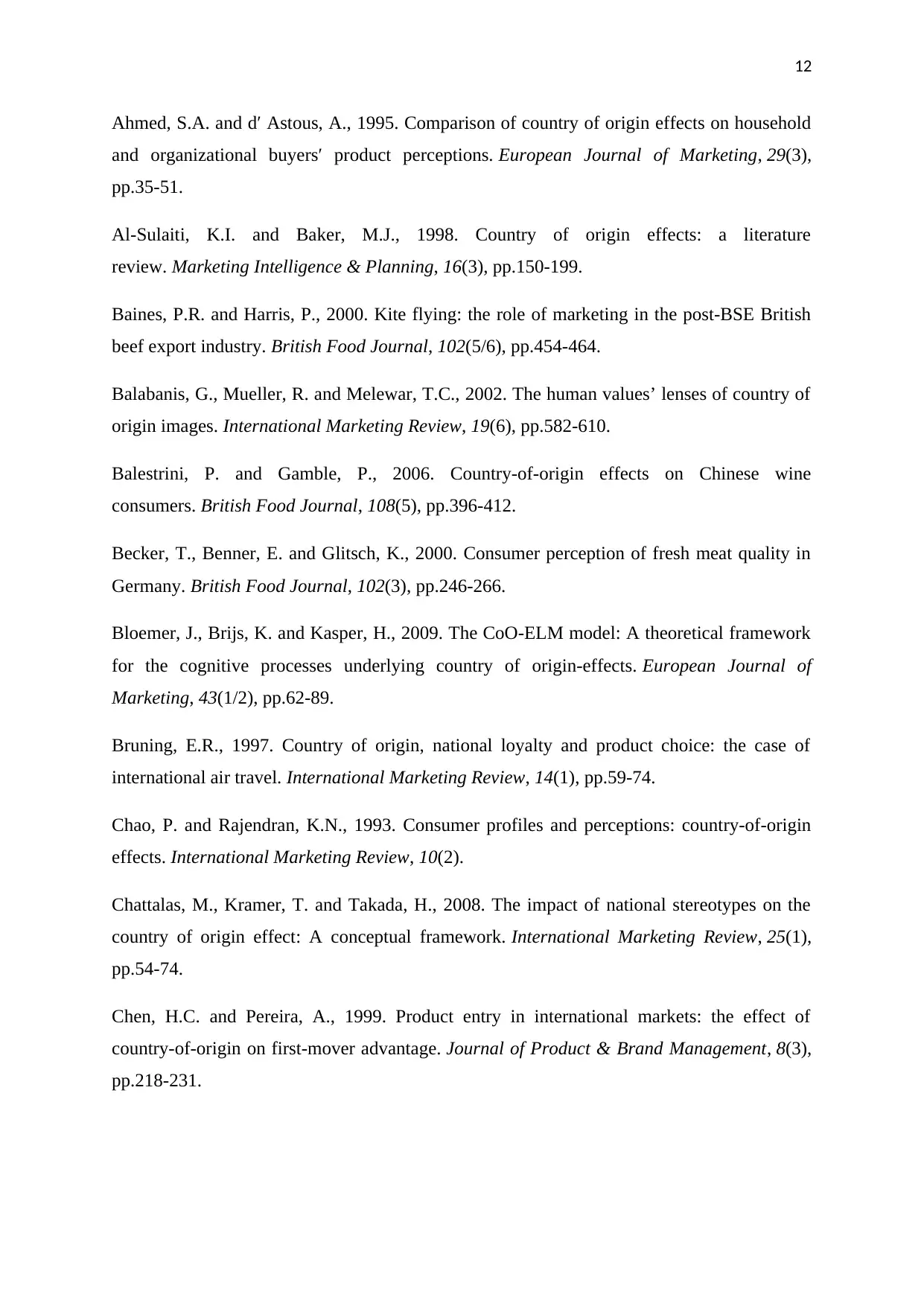
12
Ahmed, S.A. and d′ Astous, A., 1995. Comparison of country of origin effects on household
and organizational buyers′ product perceptions. European Journal of Marketing, 29(3),
pp.35-51.
Al-Sulaiti, K.I. and Baker, M.J., 1998. Country of origin effects: a literature
review. Marketing Intelligence & Planning, 16(3), pp.150-199.
Baines, P.R. and Harris, P., 2000. Kite flying: the role of marketing in the post-BSE British
beef export industry. British Food Journal, 102(5/6), pp.454-464.
Balabanis, G., Mueller, R. and Melewar, T.C., 2002. The human values’ lenses of country of
origin images. International Marketing Review, 19(6), pp.582-610.
Balestrini, P. and Gamble, P., 2006. Country-of-origin effects on Chinese wine
consumers. British Food Journal, 108(5), pp.396-412.
Becker, T., Benner, E. and Glitsch, K., 2000. Consumer perception of fresh meat quality in
Germany. British Food Journal, 102(3), pp.246-266.
Bloemer, J., Brijs, K. and Kasper, H., 2009. The CoO-ELM model: A theoretical framework
for the cognitive processes underlying country of origin-effects. European Journal of
Marketing, 43(1/2), pp.62-89.
Bruning, E.R., 1997. Country of origin, national loyalty and product choice: the case of
international air travel. International Marketing Review, 14(1), pp.59-74.
Chao, P. and Rajendran, K.N., 1993. Consumer profiles and perceptions: country-of-origin
effects. International Marketing Review, 10(2).
Chattalas, M., Kramer, T. and Takada, H., 2008. The impact of national stereotypes on the
country of origin effect: A conceptual framework. International Marketing Review, 25(1),
pp.54-74.
Chen, H.C. and Pereira, A., 1999. Product entry in international markets: the effect of
country-of-origin on first-mover advantage. Journal of Product & Brand Management, 8(3),
pp.218-231.
Ahmed, S.A. and d′ Astous, A., 1995. Comparison of country of origin effects on household
and organizational buyers′ product perceptions. European Journal of Marketing, 29(3),
pp.35-51.
Al-Sulaiti, K.I. and Baker, M.J., 1998. Country of origin effects: a literature
review. Marketing Intelligence & Planning, 16(3), pp.150-199.
Baines, P.R. and Harris, P., 2000. Kite flying: the role of marketing in the post-BSE British
beef export industry. British Food Journal, 102(5/6), pp.454-464.
Balabanis, G., Mueller, R. and Melewar, T.C., 2002. The human values’ lenses of country of
origin images. International Marketing Review, 19(6), pp.582-610.
Balestrini, P. and Gamble, P., 2006. Country-of-origin effects on Chinese wine
consumers. British Food Journal, 108(5), pp.396-412.
Becker, T., Benner, E. and Glitsch, K., 2000. Consumer perception of fresh meat quality in
Germany. British Food Journal, 102(3), pp.246-266.
Bloemer, J., Brijs, K. and Kasper, H., 2009. The CoO-ELM model: A theoretical framework
for the cognitive processes underlying country of origin-effects. European Journal of
Marketing, 43(1/2), pp.62-89.
Bruning, E.R., 1997. Country of origin, national loyalty and product choice: the case of
international air travel. International Marketing Review, 14(1), pp.59-74.
Chao, P. and Rajendran, K.N., 1993. Consumer profiles and perceptions: country-of-origin
effects. International Marketing Review, 10(2).
Chattalas, M., Kramer, T. and Takada, H., 2008. The impact of national stereotypes on the
country of origin effect: A conceptual framework. International Marketing Review, 25(1),
pp.54-74.
Chen, H.C. and Pereira, A., 1999. Product entry in international markets: the effect of
country-of-origin on first-mover advantage. Journal of Product & Brand Management, 8(3),
pp.218-231.
⊘ This is a preview!⊘
Do you want full access?
Subscribe today to unlock all pages.

Trusted by 1+ million students worldwide
1 out of 16
Related Documents
Your All-in-One AI-Powered Toolkit for Academic Success.
+13062052269
info@desklib.com
Available 24*7 on WhatsApp / Email
![[object Object]](/_next/static/media/star-bottom.7253800d.svg)
Unlock your academic potential
Copyright © 2020–2025 A2Z Services. All Rights Reserved. Developed and managed by ZUCOL.





